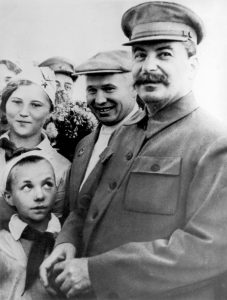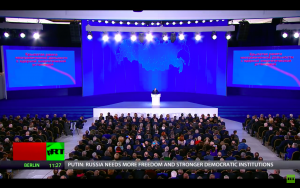In the mid-1950’s the General Secretary of the Communist Party of the Union of Soviet Socialist Republics Nikita Khrushchev had just completed his takeover of the levers of power following the death of the Leader of Nations, none other than Joseph Stalin two years earlier. The vast empire he fought so hard to lead lay in ruins. Almost nothing had been rebuilt after the devastation of WWII and Stalin’s scorched earth policies of forced collectivization by mass starvation and the purges of the late 1930’s, to say nothing of the nearly twenty million killed directly and indirectly by the invading Germans, left the country in a profound state of post traumatic disorder.
Khrushchev knew that his erstwhile allies and new adversaries in the West will not long wait to test the mettle of the new and poorly known leader. After all, he won power by keeping himself well in the shadow of the Great Leader and letting all the better-known players be purged or succumb to internal court intrigue. He also knew that his denunciation of Stalin’s “cult of personality” and rehabilitation of many political prisoners could be interpreted as a sign of weakness, both internally and more importantly externally by the West and the newly created or recreated Eastern European countries, which had been undergoing a rather ruthless process of de-Nazification and forced conversion to communist dictatorship.
The Hi-Tech Traditionalist: Motherhood And Western Fascist Feminism
He didn’t have to wait long. In 1956 Hungary attempted a rebellion against the Soviet Union with an eye to establishing neutral independence with a Western leaning foreign policy. Knowing that this would be his do or die test, Khrushchev didn’t hesitate; sending massive columns of battle-hardened Red Army armor into the center of Budapest, his suppression of the uprising was as brutal as it was quick. The world was waiting with baited breath for President Eisenhower’s response; would the US allow a democratically elected government supported by students and forward-looking intelligentsia be crushed under the weight of communist armor? In the Kremlin, nobody was less sure of his gambit than Khrushchev. Fully aware of his military’s capabilities, especially the air force and the nascent strategic missile command, he knew that they would be no match to the American Air Force and that Soviet nuclear retaliation was out of the question. He knew that American air cover for the Hungarian rebel forces could spell either a humiliating defeat for the Soviets, or a new world war for which the USSR was exceedingly ill prepared. He also knew what these outcomes would mean for him; a secret trial followed by a quick execution in Lubyanka Prison basement. But Eisenhower, the highest-decorated and most experienced military commander to occupy the oval office since Ulysses S. Grant, hesitated. The swiftness and brutality of the Soviet occupation forces in Hungary played out as Khrushchev had planned; the moment for America action came and went in the blink of an eye. Khrushchev faced his first real external policy test and prevailed.
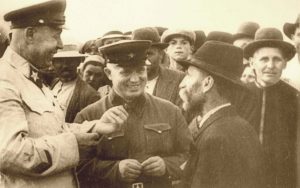
Image by ANRM, Fototeca, 35684
This triumph was a highly teachable moment for Khrushchev and his successor all the way down to the present day. The West, they found, led by the United States, was susceptible to puffery and grandstanding. This susceptibility was in many ways the result of the decisive victory the KGB had scored after the War over its Western counterparts, the newly-formed CIA and MI5. Both services had a penchant, one that they still possess, of hiring known communists and placing them in the highest positions. Amazingly, John Brennan, president Obama’s CIA chief was a member of the American communist party before he was hired by the CIA as a junior operative, a fact that he had not bothered hiding. The British MI5 was rife with Oxford and Cambridge educated communists and thus was 100% transparent to the Russians. Conversely, the KGB had excellent counter-intelligence operations that were yet uncompromised by disillusioned officers as they would become in the 1970’s. Eisenhower, betrayed as he was by his own intelligence services, did not have anything remotely approaching an accurate picture of the Soviets’ actual military capabilities, which were in matter of fact much weaker than he believed them to be.
As often happens, Khrushchev’s reliance on puffery finally spelled his doom when he pushed the boundaries with his much ridiculed speech to the UN in which he banged his shoe on the podium and promised to “bury” America and finally when he pushed JFK one step too far in the Cuban missile crisis. Judged dangerously unstable by his Politburo, Khrushchev was replaced in a quiet coup d’état shortly thereafter. What followed was a period of stagnation, decline, and finally disintegration, a period that the current Russian president Vladimir Putin well remembers and which formed his entire world view.
Today, president Putin finds himself in much the same predicament as Khrushchev over half a century ago, but without the excuse of having just won a world war against the greatest military force the world had ever seen. The Russian Federation has half the population of the Soviet Union and less than half of its industrial and agricultural heartlands. Its economy is based on the export of hydrocarbons, a market which is already saturated, vulnerable to emerging technologies, and reliant on self-restraint by America, self-restraint which president Trump is reluctant to exercise. It is a true testament to the dire straits that Russia finds itself in that Putin has recently had to embark on the extraordinary course of nuclear doomsday puffery, in effect promising to annihilate the entire Planet Earth if Russia’s geopolitical interests are infringed upon much further.
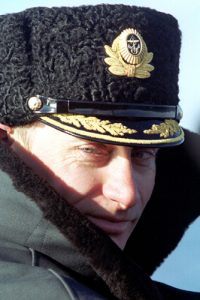
Image by Kremlin.ru
Putin’s somewhat pathetic insistence that Russia has just developed a qualitatively new doomsday weapon capable of destroying the US has received very little in the way of response from the Pentagon beyond a few bemused smiles by retired generals on the cable news networks. The reasons for this are multiple. Perhaps the principal reason is that nobody in the Pentagon has ever doubted Russia’s ability to annihilate America, just as they do not doubt that they can deliver a similarly devastating attack on Russia, even as second strike. America’s anti-missile capabilities were never intended (and this was made clear to the Russians) to defeat an all-out nuclear strike by Russia. Rather they are intended to intercept a single ballistic missile launched by a rogue technologically inferior regime such as North Korea or Iran. Thus the somewhat ridiculous Russian insistence on having developed an operational hypersonic cruise missile capable of reaching anywhere in America undeterred by American defenses is more of a sign of weakness than of strength.
The Hi-Tech Traditionalist: The Radical Infantilization of America
America does not need sophisticated humint (human intelligence) as it did in the Cold War days to know with certainty that no hypersonic cruise missiles are currently operational. The reasons for this are very simple; anything that flies anywhere around the globe is tracked by American satellites. A hypersonic cruise missile flying at low altitude as it would need to do to avoid radar detection and possible interception would generate a shockwave that would certainly be strong enough to trigger the many seismic sensors located around the globe. Israeli jets often make a point to the Hezbollah in Lebanon by “breaking the sound barrier”, i.e. flying at low supersonic speeds and at low altitudes above those Beirut neighborhoods in which the Hezbollah are concentrated. The shockwaves resulting from supersonic flight at low attitudes easily shatter windows and rattle high-rise buildings. Since the pressure drop across a shockwave is proportional to the Mach number (the multiple by which the aircraft speed exceeds the speed of sound), a large hypersonic cruise missile with multiple nuclear warheads, traveling at over Mach 5.0, would generate a very significant shockwave that would not fail to be picked up by terrestrial and maritime seismic arrays.
In addition, the fallout of radioactive isotopes from a missile that has, as the Russians have boasted, nuclear propulsion, would be considerable. The reason for that is also simple: missiles are propelled by expelling gases from their engines at speeds that exceed their own speed of travel. No other method exists or can exist within known physics to propel objects at anything approaching supersonic, let alone hypersonic speeds. A nuclear-powered missile would use nuclear reaction to heat and expand air that is rammed into the missile’s engine from its front intake nozzle, adding energy to it and expelling it from the rear of the missile at much higher velocity. There can be no doubt that significant markers in the form of radioactive isotopes would be mixed in with the missile’s exhaust stream and that such elements world be picked up by the very well developed global network of radiation sensors.
It is no wonder then, that the official response to Putin’s grand presentation, delivered not by Secretaries Tillerson or Mattis, but by Heather Nauert, the State Department spokeswoman, openly ridiculed any assertions of radically new weaponry, referring instead to the inadvisability of reliance on “cheesy videos” as a means of diplomacy. The unintimidated American response had not gone unnoticed in Russia and, it is fair to say, did not help Putin accomplish even the minimal goal of internal propaganda in support of Putin’s reelection bid.
There’s an underlying hard truth behind Putin’s puffery; his hand is weaker than Khrushchev’s had ever been. The Russian military has not engaged in a meaningful ground war against an organized enemy since 1945. Their engagements in Afghanistan, Chechnya, and Georgia have been against small forces of insurgents, and even then they did not distinguish themselves. In contrast, American military fought and won major engagements against a relatively well-equipped and very experienced adversary, Saddam’s Iraqi army, in 1990 and again in 2003. In its ongoing operations in Syria, Russia’s air force lost at least two aircraft to accidents flying off their now decommissioned sole aircraft carrier, one to a Turkish F-16, and another to ground fire by ill-equipped and ill-trained Syrian rebel forces. In comparison, the F-16 recently lost by Israel was the target of 26 enemy missiles and was the first aircraft Israel had lost to enemy fire in over a quarter century of constant warfare. On the ground, Russian special forces disguised as mercenaries were annihilated just recently by the American forces in Syria with a loss of nearly the entire force, upwards of a hundred men. The recesses of Russian language Twitter are still reverberating with frank accounts of this drubbing by the families and friends of those who managed to survive or witness it.
In the 1950’s and the 1960’s when the Russian puffery doctrine was first developed and perfected, Russia had its empire intact, an overwhelming advantage in intelligence, and massive battle-hardened armored columns located only a few kilometers from Vienna and Berlin. Russia’s military industries were self-sufficient, their supply chains never reaching beyond the iron curtain. Today, Russia’s military is largely untested, and where it has been tested, it had often come up short. Intelligence is dominated by sigint (signal intelligence), an area in which the US has unparalleled superiority, though it is no better served by its atrocious personnel choices than it had been in the past. Today, Russia’s military industries rely on electronic components that originate well outside Russia sphere of influence, leaving it vulnerable to wartime shortages.
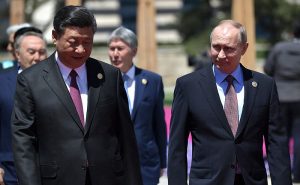
Image by The Russian Presidential Press and Information Office
What Russia urgently needs is a Winston Churchill, a leader who can tell the truth to the Russian people just like Sir Winston told the British people in the immediate aftermath of WWII: Russia’s imperial days, its days as a global superpower are well behind her. She now needs to regroup, focus on the plight of its long-suffering population, redirect resources to the development of advanced industry and agriculture, healthcare and education. In Eurasia, a new power has risen, and it is Emperor Xi, not Czar Vladimir that is going to challenge the American hegemony from this day forward.


